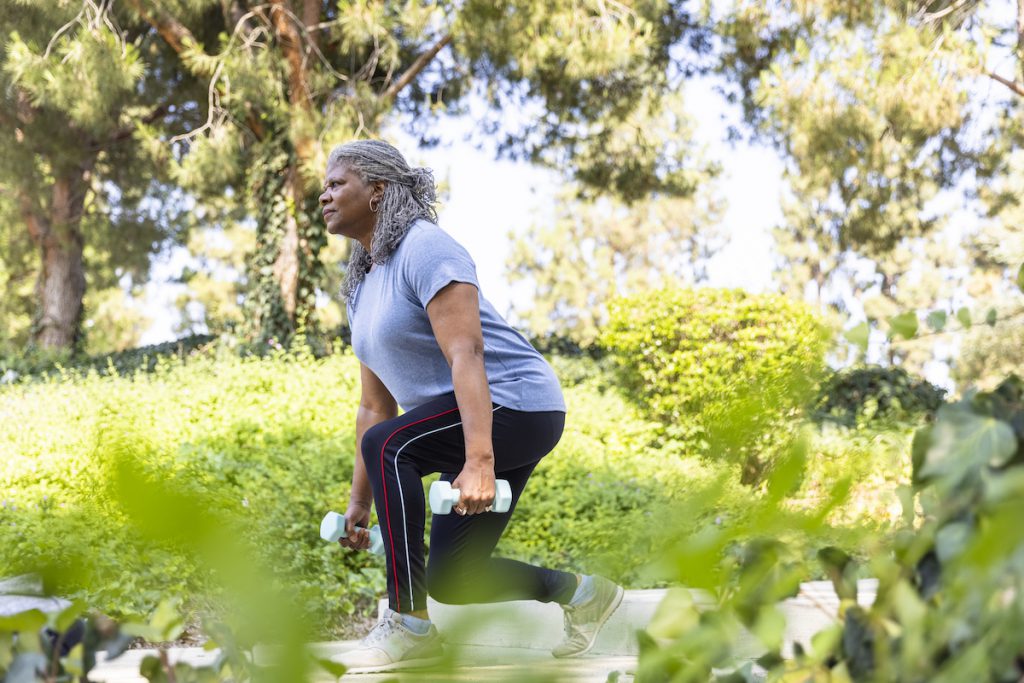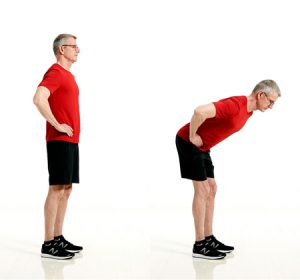Strength Training for Older Adults: The SilverSneakers Guide
Strength training is key to maintaining mobility, balance, and range of motion as you get older. Here’s what you need to know, and how to get started.

Question: What form of exercise can help reduce your risk of falls, prevent heart attack, and make it easier to pick up your grandkids?
If you answered “strength training,” you’d be correct.
“Strength training is important for anybody, but it’s especially key for older adults,” says Damien A. Joyner, C.P.T., a personal trainer who specializes in healthy aging. He is the owner of Incremental Fitness in San Diego, California.
That’s because strength training offers more benefits than just keeping your muscles strong. It can help you maintain balance and mobility as you age, and even help minimize your risk for certain diseases.
Strength training may sound intimidating if you’re new to this kind of workout. But beginning a routine is easier than you might think. Here are tips on getting started—plus the benefits you can expect once you begin.
Get and stay fit with SilverSneakers!Classes and events are happeningright nowat participating gyms, online through SilverSneakers LIVE, and at community centers near you. Activate your free online account to get started.
What is strength training?
Also known as resistance training, strength training is a physical activity that uses some form of weight to work your muscles, according to the National Institute on Aging (NIA). When you lift a heavy object against the pull of gravity, your muscles contract. Over time, this type of motion helps keep your muscles strong.
You might picture strength training as someone lifting heavy dumbbells — and you’d be right. But strength training has many forms. (More on this in Do I need weights or special equipment to strength train? below.)
And your arms aren’t the only body part that can do this “lifting” motion. There are strength workouts that target your legs, core, and more.
What are the health benefits of strength training for older adults?
Strength training offers major health advantages for your whole body. Some of these perks are especially beneficial for older adults. Take a look at just a few reasons to add strength moves to your workout regimen.
Build everyday strength. Studies show that 30 percent of older adults have trouble walking, getting out of a chair, and climbing stairs.
“Real life calls for strength and people often underestimate that, so things like picking up groceries, opening car doors, and picking up grandkids get difficult,” Joyner says.
Strength training builds muscle, which can make these everyday activities easier.
Strengthen your bones. Osteoporosis is a bone disease that makes your bones weak and more likely to break. It becomes more common with age. The Osteoporosis Workgroup estimates that 10 million people ages 50 and older have osteoporosis.
Another 43 million people have low bone mass, putting them at risk for osteoporosis and fractures. Research shows that strength training can slow bone loss in people with and without osteoporosis, reducing the risk of fractures.
Lower your risk of falls. Falls are the leading cause of death by injury for people ages 65 and older. Every year, 3 million older adults are treated in U.S. emergency rooms for fall-related injuries, according to the Centers for Disease Control and Prevention (CDC).
Strengthening your lower body muscles with resistance training is one of the keys for preventing falls.
Reduce your risk for certain diseases. Researchers from a 2019 Medicine & Science in Sports & Exercise study found that doing resistance exercises for 1 hour per week — or even less often — could reduce your risk of heart attack or stroke by up to 70 percent.
Help control your blood sugar. Diabetes affects roughly 33 percent of older adults. And this group is at higher risk for diabetes complications like low blood sugar, kidney failure, and heart disease, per the Endocrine Society.
According to a 2017 meta-analysis, strength training can help manage your blood sugar levels, which may lower your risk of complications.
Can strength training help me lose weight?
“Strength training can definitely help with weight loss,” Joyner says. It burns calories and builds active muscle tissue, which uses more energy (i.e., calories) throughout the day.
It’s best to do both strength training and cardio exercise (aka aerobic exercise) for weight loss. And be sure to combine your workouts with a balanced diet.
Cardio exercise tends to burn more calories than strength training. Meanwhile, a balanced diet ensures you don’t eat back the calories you burned.
Do I need weights or special equipment to strength train?
The short answer: No, but you can use equipment if you’d like.
All you need for an effective strength training workout is your own body weight. Starting with bodyweight exercises is a great way to learn proper form and build your confidence, Joyner notes.
Resistance bands can make strength exercises harder. These lightweight, inexpensive tubes provide resistance when stretched. You can find styles with handles or closed-loop variations to suit your preferences.
Recommended reading: The Beginner’s Guide to Exercise Bands
Free weights (like dumbbells, kettlebells, and barbells) and weight machines can also make strength exercises more challenging. Weight machines follow a fixed path, which makes the exercises easier to learn for beginners.
However, free-weight exercises typically build better balance and core strength. Just be sure to get instructions on how to do free weight exercises safely first, Joyner says.
Recommended reading: Free Weights Versus Strength Machines: Which Is Best?
You may also choose to incorporate medicine balls and fitness balls into your strength workouts.
How often should I strength train to see results?
The U.S. Department of Health and Human Services (HHS) recommends strength training at least twice weekly for health benefits.
You can go up from there, but Joyner says two strength workouts per week should be enough if you’re active on the other days. Great activities include gardening, hiking, walking, swimming, and sports like golf and pickleball.
The CDC also recommends performing balance activities three times per week. For example, walking backward, standing on one leg, or using a wobble board. Research shows that tai chi is another good option for building balance.
Recommended reading: Take the 7-Day Better Balance Challenge!
How can I get started with strength training?
Even if you’ve never done any kind of strength training before, it’s not too late to start. Use these tips to begin your strength-training routine.
Find your “why.” Think about what you want to achieve through strength training and use this to stay motivated.
“It could be that you want to move better for your grandkids and loved ones, go on vacations, or just live your retirement with more excitement,” Joyner says.
Build a foundation. There are several basic movements that belong in a well-rounded strength routine. Joyner recommends starting with the following bodyweight exercises:
Subscribe to our newsletter
It's quick and easy. You could be one of the 13 million people who are eligible.
Already a member? Click to discover our 15,000+ participating locations.
Follow Us
- Lunges (forward, reverse, or side)
- Wall pushups
- Hip hinge (shown)

Work your way up to doing three sets of 10 to 12 reps per exercise.
Once those movements feel easy, try adding weight with resistance bands or hand weights.
Recommended workout: The Best Strength-Training Workout for Beginners
Try a group fitness class. SilverSneakers classes are a great way to get started with strength training. Our classes are designed for older adults. And you can learn from supportive instructors who are trained in senior fitness.
“Instead of working out on your own, you have someone instructing you, and it would also be more fun,” Joyner says.
There are strength-training classes for all fitness levels, including:
- SilverSneakers Classic
- Bodyweight Boot Camp
- Cardio & Strength (Express)
- Lower Body Strength (Express)
- Upper Body Strength (Express)
- Seated Strength (Express)
- Total Body Strength
Find your favorite class at participating gyms, online through SilverSneakers LIVE, and at community centers. (Check your eligibility instantly here.)
Not eligible for SilverSneakers? You can still get 200+ free SilverSneakers On-Demand videos and stay in touch with us by creating your online account.
Are there any risks to strength training?
As with any form of exercise, strength training comes with a few risks. Lifting weights that are too heavy, training too often, and having poor form can lead to muscle and joint damage, warns the American Academy of Family Physicians.
For this reason, Joyner recommends working with a personal trainer for one or two sessions. They can help you start a strength routine and teach you how to perform exercises with proper form.
It’s also important to notice how you feel in the days following a workout. It’s normal for muscles to feel sore, but if any part of your body becomes swollen or you experience sharp pain, you need to back off, according to Johns Hopkins Medicine. Talk to a physical therapist or doctor if things don’t improve.
Finally, get cleared by your doctor before starting a strength training program. This is especially important if you have a chronic condition. For example, people with osteoporosis may need to avoid specific exercises.
When in doubt, Mayo Clinic suggests asking your doctor or physical therapist which exercises are safe.
Ready to do a strength-training workout? Press play to try this 10-Minute version of our popular SilverSneakers Classic class.
All you need is a pair of comfortable shoes and a sturdy chair. Optional: If you have a soft play ball or fitness ball at home, you can use that for some of the exercises.
See our sources:
How strength training benefits older adults: National Institute on Aging
Study on physical limitations of older adults: American Journal of Public Health
Osteoporosis facts: U.S. Department of Health and Human Services
Study on strength training for bone health: Endocrinology and Metabolism
The dangers of falls: Centers for Disease Control and Prevention
Study on resistance exercises and heart disease risk: Medicine & Science in Sports & Exercise
Diabetes and older adults: Endocrine Society
How strength training can help manage diabetes: Diabetes Therapy
Comparing strength training and cardio for weight loss: Beaumont
Exercise guidelines for Americans: U.S. Department of Health and Human Services
Study on Tai Chi benefits for balance: Journal of Exercise Rehabilitation
Strength training safety overview: American Academy of Family Physicians
Shoulder pain overview: Johns Hopkins Medicine
How to exercise safely with osteoporosis: Mayo Clinic
Check Your SilverSneakers Eligibility Instantly
SilverSneakers members can go to thousands of gyms and fitness locations across the nation, plus take SilverSneakers LIVE online classes that are designed for seniors of all levels. If you have a Medicare plan, it may include SilverSneakers—at no additional cost. Check your eligibility instantly here.
Already a member? Get your SilverSneakers member ID and exclusive fitness content by activating your online account here.
Not eligible for SilverSneakers? You can still get 200+ free SilverSneakers On-Demand videos and stay in touch with us by creating your online account.




